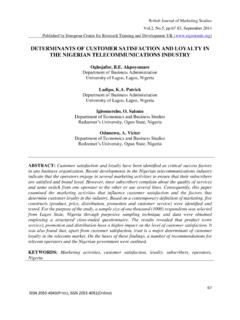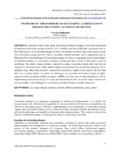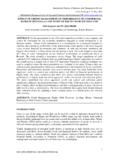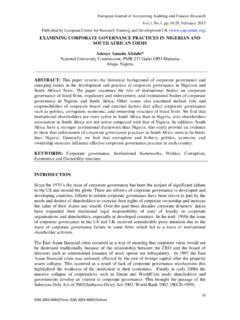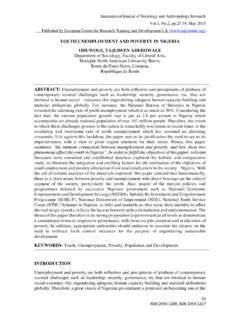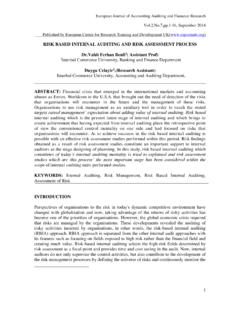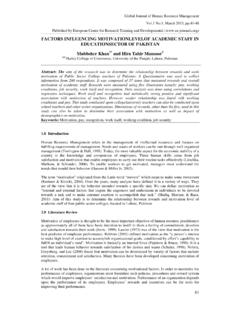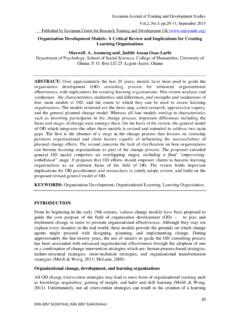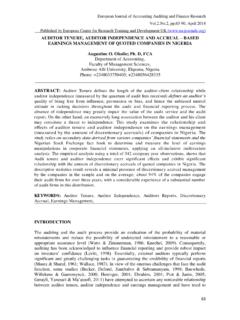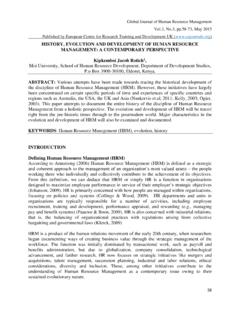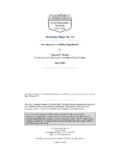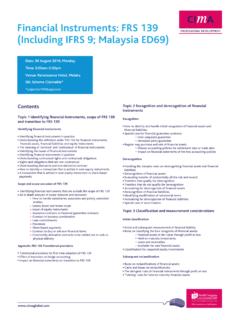Transcription of FINANCIAL SUSTAINABILITY FACTORS OF HIGHER …
1 International Journal of Education Learning and Development , , , April 2015. Published by European Centre for Research Training and Development UK ( ). FINANCIAL SUSTAINABILITY FACTORS OF HIGHER EDUCATION. INSTITUTIONS: A PREDICTIVE MODEL. Amos Oppong Afriyie, PhD. Valley View University, P. O. Box AF 595, Adentan, Ghana. ABSTRACT: Private and public HIGHER education institutions have had the problem of FINANCIAL un- SUSTAINABILITY in recent years. United Kingdom and European Union have instituted programs to work on FINANCIAL SUSTAINABILITY of HIGHER education. To achieve FINANCIAL SUSTAINABILITY of HIGHER education, institutions need to maintain or increase internally-generated funds that are regular, without future compromises.
2 The paper establishes the legitimacy for future work needed for the variables to pursue sustainable growth. The study was designed to explore theories behind FINANCIAL SUSTAINABILITY and established possible correlation between the sustainable growth rate and contributing FACTORS that are sustaining the financing of HIGHER education institutions. Quantitative research methodology was use for the research design with instrument on HIGHER educational institutions across the globe. Results opened an important opportunity for discussion on FINANCIAL SUSTAINABILITY in HIGHER educational institutions. The outcome states that the predictive model is key to FINANCIAL SUSTAINABILITY for HIGHER educational institutions.
3 KEYWORDS: SUSTAINABILITY , FINANCIAL SUSTAINABILITY , Public Relations, Organizational culture, Investment portfolio, Networking, Authentic leadership and Sustainable growth rate INTRODUCTION. SUSTAINABILITY has come to stay for both society and different institution. It is encompassing and the power of its synergy makes it significant to global and local application as asserted by [54]. This, [55] stated that it is described as longevity of the organization, maintenance of core principles or purposes, and responsibility to external needs (p. 1) For-profit organizations, SUSTAINABILITY is concerned with survival in a competitive market, which increasingly includes global competition and relates to maintenance of core principles or purposes as pressures may necessitate changes in operations and policies [56].
4 SUSTAINABILITY movement thrive around many communal ideas of helping each other in our environment, 2) communal responsibility, 3) what can help the whole community to survive in the future and, 4) and to create a foresight that can be envisage as acceptable branding for the future. This calls for environmental and communal responsibility which leads to SUSTAINABILITY of the society. In this case a communal stakeholders group comes together and with trust and reciprocity designed an institution that lead to 17. ISSN 2054-6297(Print), ISSN 2054-6300(Online). International Journal of Education Learning and Development , , , April 2015.
5 Published by European Centre for Research Training and Development UK ( ). organizational SUSTAINABILITY programs, which in turn creates a synergy that generate trust and reciprocity that bring a good will [11]. Through this SUSTAINABILITY and public relations, social, and governance FACTORS are seen as public interest that affect human, societal, and environmental well-being and that are increasingly relevant to business and finance operations . [10], para. 10). With the above in mind SUSTAINABILITY can be looked at as an institutional and institutional'. supply management. In an expanding economy, companies do well to invest in common good growth initiatives, and these expenditures often pay off and promote a perception of FINANCIAL stability.
6 [29]. To lead the economy or institutions into economic SUSTAINABILITY positive public relations become increasingly of the most recent trends is interpreting SUSTAINABILITY initiatives which is appreciated and recognized the challenges of organizational change initiatives. Thus, organizations SUSTAINABILITY potential must be prepared to overcome major barriers such as luck of trust, loyalty, abuse of power and greed associated with organization- wide culture change In his write-up, [49] asserts that SUSTAINABILITY refers to the ability of a society, ecosystem, or any such ongoing system to continue functioning into the indefinite future without being forced into decline through exhaustion of key resources (p.)
7 24). FINANCIAL SUSTAINABILITY requires institutions to cover all transaction costs with return on equity and consequently functions without subsidies [49], p. 26). Both SUSTAINABILITY and FINANCIAL SUSTAINABILITY demand .. long term planning which is a vital discipline for creating and maintaining FINANCIAL SUSTAINABILITY . [30] p. 7). Without a doubt, it requires a shift away from the short-term perspective associated with annual budgeting [30], p. 7) to the ability to fulfill current engagements. The short term perspective should not compromise the future perspective, which pertains to the SUSTAINABILITY of the institution.
8 Thus it goes without saying, FINANCIAL SUSTAINABILITY becomes the institution's capacity to fulfill current obligation without compromising its ability to meet future FINANCIAL obligations. BACKGROUND. Current reality of HIGHER educational institutions Since the 21st century, the challenges facing the AHEIs have been growing. In 2005, the Review and Herald published that the first Adventist College was planning to close its doors due to FINANCIAL un- SUSTAINABILITY . This is the longest serving HIGHER educational institution that the church has. Apart from the problem of not finding enough qualified Adventist professors, [38].
9 Said the institution refused to take the approach of system thinking as a discipline for seeing wholes (p. 34). The challenge called for ways to tackle and solve problems. [38] continued to say that there was a need for a framework for seeing inter-relationship rather than things (p. 34). Six years later, the Review and Herald in August 2011, reported the closure of the said College. [48] (as cited in [38] took this idea further when he said that church related colleges and 18. ISSN 2054-6297(Print), ISSN 2054-6300(Online). International Journal of Education Learning and Development , , , April 2015. Published by European Centre for Research Training and Development UK ( ).)
10 Universities have neglected the power of cooperation, collaboration, collectivity, networking, and long-term FINANCIAL sustainable growth (p. 34). [48] calls AHEI administrators to change their perspective from seeing parts to seeing whole (p. 34). This will reveal the true reality about Adventist HIGHER education institutions and their condition. The scarcity of church resources is a concern and its ability to finance the needs of its HIGHER educational institution is wanting. Although the [21] of the church states that appropriations shall be made to the organizations in the division for their requirements as the division committee may determine (p.)
